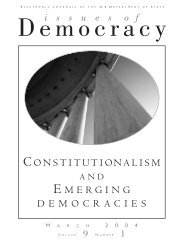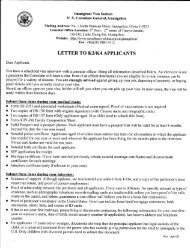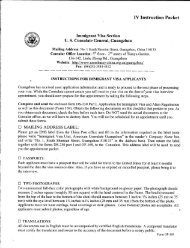- Page 6:
CHAPTER 1: EARLY AMERICAOUTLINE OF
- Page 18:
CHAPTER 1: EARLY AMERICAOUTLINE OF
- Page 22:
C H A P T E R2THECOLONIALPERIODPilg
- Page 26:
CHAPTER 2: THE COLONIAL PERIODOUTLI
- Page 30:
CHAPTER 2: THE COLONIAL PERIODOUTLI
- Page 34:
CHAPTER 2: THE COLONIAL PERIODOUTLI
- Page 38:
John Smith,the stalwartEnglish expl
- Page 42:
Benjamin Franklin: scientist, inven
- Page 46:
Thomas Jefferson, author of the Dec
- Page 50:
C H A P T E R3THE ROADTOINDEPENDENC
- Page 54:
CHAPTER 3: THE ROAD TO INDEPENDENCE
- Page 58:
CHAPTER 3: THE ROAD TO INDEPENDENCE
- Page 62:
CHAPTER 3: THE ROAD TO INDEPENDENCE
- Page 66:
C H A P T E R4THEFORMATIONOF ANATIO
- Page 70:
CHAPTER 4: THE FORMATION OF A NATIO
- Page 74:
CHAPTER 4: THE FORMATION OF A NATIO
- Page 78:
CHAPTER 4: THE FORMATION OF A NATIO
- Page 82:
CHAPTER 4: THE FORMATION OF A NATIO
- Page 86:
CHAPTER 4: THE FORMATION OF A NATIO
- Page 90:
Henry Clay of Kentucky,although nev
- Page 94:
Union General Ulysses S. Grant, who
- Page 98:
Sitting Bull, Sioux chief who led t
- Page 102:
Left, opposite page, immigrants arr
- Page 106:
Orville Wright, who built and flew
- Page 110:
C H A P T E R5WESTWARDEXPANSIONANDR
- Page 114:
CHAPTER 5: WESTWARD EXPANSION AND R
- Page 118:
CHAPTER 5: WESTWARD EXPANSION AND R
- Page 122:
CHAPTER 5: WESTWARD EXPANSION AND R
- Page 126:
CHAPTER 5: WESTWARD EXPANSION AND R
- Page 130:
CHAPTER 6: SECTIONAL CONFLICTOUTLIN
- Page 134:
CHAPTER 6: SECTIONAL CONFLICTOUTLIN
- Page 138:
CHAPTER 6: SECTIONAL CONFLICTOUTLIN
- Page 142:
CHAPTER 7: THE CIVIL WAR AND RECONS
- Page 146:
CHAPTER 7: THE CIVIL WAR AND RECONS
- Page 150:
CHAPTER 7: THE CIVIL WAR AND RECONS
- Page 162:
The snow-covered Old Granary cemete
- Page 168:
Aerial view of the Great Serpent Mo
- Page 172:
Six-year-old Mary Zheng straightens
- Page 176:
OUTLINE OF U.S. HISTORYTop, the Wor
- Page 188: C H A P T E R9DISCONTENTANDREFORMSu
- Page 192: CHAPTER 9: DISCONTENT AND REFORMOUT
- Page 196: CHAPTER 9: DISCONTENT AND REFORMOUT
- Page 200: CHAPTER 9: DISCONTENT AND REFORMA N
- Page 206: CHAPTER 10: WAR, PROSPERITY, AND DE
- Page 210: CHAPTER 10: WAR, PROSPERITY, AND DE
- Page 214: CHAPTER 11: THE NEW DEAL AND WORLD
- Page 218: CHAPTER 11: THE NEW DEAL AND WORLD
- Page 222: CHAPTER 11: THE NEW DEAL AND WORLD
- Page 226: CHAPTER 11: THE NEW DEAL AND WORLD
- Page 230: Men and women strikers dance the ti
- Page 234: In perhaps the mostfamous photograp
- Page 238: Lucille Ball (second from left) wit
- Page 244: Thurgood Marshall, one of the champ
- Page 248: Antiwar demonstrators and police cl
- Page 252: Civil rights leader and political a
- Page 256: C H A P T E R12POSTWARAMERICAMoving
- Page 260: CHAPTER 12: POSTWAR AMERICAOUTLINE
- Page 264: CHAPTER 12: POSTWAR AMERICAOUTLINE
- Page 268: CHAPTER 12: POSTWAR AMERICAOUTLINE
- Page 272: CHAPTER 12: POSTWAR AMERICAOUTLINE
- Page 276: CHAPTER 13: DECADES OF CHANGE: 1960
- Page 280: CHAPTER 13: DECADES OF CHANGE: 1960
- Page 284: CHAPTER 13: DECADES OF CHANGE: 1960
- Page 288: CHAPTER 13: DECADES OF CHANGE: 1960
- Page 292:
CHAPTER 13: DECADES OF CHANGE: 1960
- Page 296:
Cable News Network (CNN) report fro
- Page 300:
Americans’ love affair with the a
- Page 304:
C H A P T E R14THENEWCONSERVATISMAN
- Page 308:
CHAPTER 14: THE NEW CONSERVATISM AN
- Page 312:
CHAPTER 14: THE NEW CONSERVATISM AN
- Page 316:
CHAPTER 14: THE NEW CONSERVATISM AN
- Page 320:
C H A P T E R15BRIDGETOTHE21 STCENT
- Page 324:
CHAPTER 15: BRIDGE TO THE 21ST CENT
- Page 328:
CHAPTER 15: BRIDGE TO THE 21ST CENT
- Page 332:
CHAPTER 15: BRIDGE TO THE 21ST CENT
- Page 336:
CHAPTER 15: BRIDGE TO THE 21ST CENT
- Page 340:
BIBLIOGRAPHYOUTLINE OF U.S. HISTORY
- Page 344:
INDEXOUTLINE OF U.S. HISTORYmigrant
- Page 348:
INDEXOUTLINE OF U.S. HISTORYEnforce
- Page 352:
INDEXOUTLINE OF U.S. HISTORYKennedy
- Page 356:
INDEXOUTLINE OF U.S. HISTORYSoviet
- Page 360:
INDEXOUTLINE OF U.S. HISTORYRoberts
- Page 364:
INDEXOUTLINE OF U.S. HISTORYXYZ Aff
- Page 368:
PHOTO CREDITS:Credits from left to












